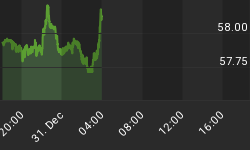On Monday, October 18th 1987, the Dow Jones Industrial Average lost 508 points (22%). There are many theories as to why the crash occurred, but the simple truth is that the panic stemmed from a sharp rise in interest rates. Likewise, another stock market crash awaits investors on the other side of tapering.
Rising interest rates twenty six years ago were a direct result of surging inflation. The year 1987 started out with very benign inflation. Consumer Price Inflation in January of that year showed that prices were up just 1.4% from the year ago period. However, CPI inflation surged to an annual increase of 4.4% by October. Rapidly rising inflation put fear back in the minds of the bond vigilantes, who remembered vividly how the former Fed Chairman, Paul Volcker, had to raise the Fed Funds Rate to nearly 20% in order to vanquish inflation just six years prior. The worry was that the new Chairman, Alan Greenspan, would soon be forced to follow in his predecessor's footsteps and start aggressively raising the Funds Rate. That fear helped send the Ten-Year Note yield surging from just above 7%, in January 1987, to over 10.2%, the week before Black Monday.
The stock market had soared by 22% in the 12 months prior to the crash of '87. In similar fashion, the Dow Jones Industrial Average has risen 21% since December of 2012, and is up nearly 150% since March of 2009. Of course, many pundits like to claim the market is not as overvalued now as it was then--the PE ratio was 23 in '87, while it is 16 today.
But, what those same gurus neglect to realize is that the "E" in the PE ratio is far more artificially derived today than it was before the great crash. Back in 1987, the range for the Fed Funds Rate was a far more reasonable 6.4%-7.2%. And the total non-financial debt of the nation was 176% of GDP--lofty, but still manageable. That compares with a Fed Funds Rate of 0.08% today, and total debt of 245% of GDP. Therefore, since interest rates are dramatically lower and debt is significantly higher than during 1987, it seems logical to conclude that the earnings of corporations and indeed the economy itself are in a far more unsustainable condition.
The same stock market carnage awaits investors just around the corner if the Fed decides it is time to end QE. Only this time the spike in rates won't be caused by inflation but by the central bank itself. It doesn't matter if inflation causes investors to fear that the Fed will raise rates (as it did 1987); or if borrowing costs increase due to the fact that the Fed has to stop its indiscriminant and massive manipulation of the yield curve--the result will be the same.
The Doves at the helm of the Fed realize this and that is why they are extremely reluctant to end QE. Investors most likely have at least until March of next year before they have to worry about a genuine tapering of Fed asset purchases...if at all; because the economy should take another turn downward due to the implementation of the Unaffordable Care Act and interest rates that have already increased. Nevertheless, it is essential to have a plan in place to preserve your assets and profit from the equity market crash in the unlikely event the Fed does go down the tapering road early next year.
If the Fed does not begin winding down QE by the early part of 2014, the markets will understand that the central bank will be in the debt monetization business for many years to come and risk assets will soar. On the other hand, if the Fed begins tapering assets within the next few months the markets and economy will tumble. The global economy sits on a narrow ledge. On the one side there exists massive asset bubbles and inflation; and on the other side there lies a deflationary depression. It is now crunch time for the Fed to choose which way we fall.
















